Predictive Maintenance in Aerospace – Innovative Use Cases

The aerospace sector is operating on an archaic data management model that lacks breadth and visibility to detect patterns or to enable early failure detection and isolation. For once, the conservative nature of this heavily regulated sector makes it costly and time consuming to develop and certify new solutions and services based on emerging technologies.
As airplanes get more and more connected to the internet, maintenance data will grow exponentially making traditional methods of data management no longer sustainable. New approaches for data storage, access, and processing is needed to minimize aircraft turnaround time while further improving safety and cutting down maintenance cost. The purpose of this article is to present innovative case studies on predictive maintenance in the aeronautics industry.
Background
A variety of challenges can delay aircraft turnaround time including initiating and tracking maintenance transactions, finding appropriate diagnostics procedures, tracking task progress, individualizing mainte-nance records for specific aircraft, and selecting and procuring replacement parts and resources. There are several risks in the way of a flawless execution of this maintenance procedure including problematic access to information stored in multiple physical and electronic repositories, inconsistent delivery of procedure updates, accurate task tracking, and timely generation of necessary sing-offs. Moreover, making the right diagnosis and correctly identifying the root cause of a declared failure is no straightforward task. Predicting failures based on collected data over a long period of time is even more daunting.
The emergence of „Artificial Intelligence“ (AI) techniques – in particular Deep Learning – have revived interest in the topic of prognostics that witnessed only a moderate success over the last decade. Currently, there is a research trend emphasizing the development and optimization of maintenance infrastructure with a perspective to advance diagnosis and prognosis and cut down aircraft turnaround time. Such a trend will benefit from collecting and storing aircraft maintenance data in the clouds with built in AI capabilities enabling global collaboration from all involved parties in the aviation industry.
The US Air Force and aerospace OEMs are currently advancing the concept of aircraft “digital twin” which is a data model of a specific tail number in a bid to eliminate unplanned downtime and to minimize turnaround time based on well documented history of operation and maintenance of the specific aircraft of interest. This approach makes the maintenance operation in the heart of a continuous improvement process of the whole flying experience enabling new concepts of optimization/perspective and “real time” maintenance.
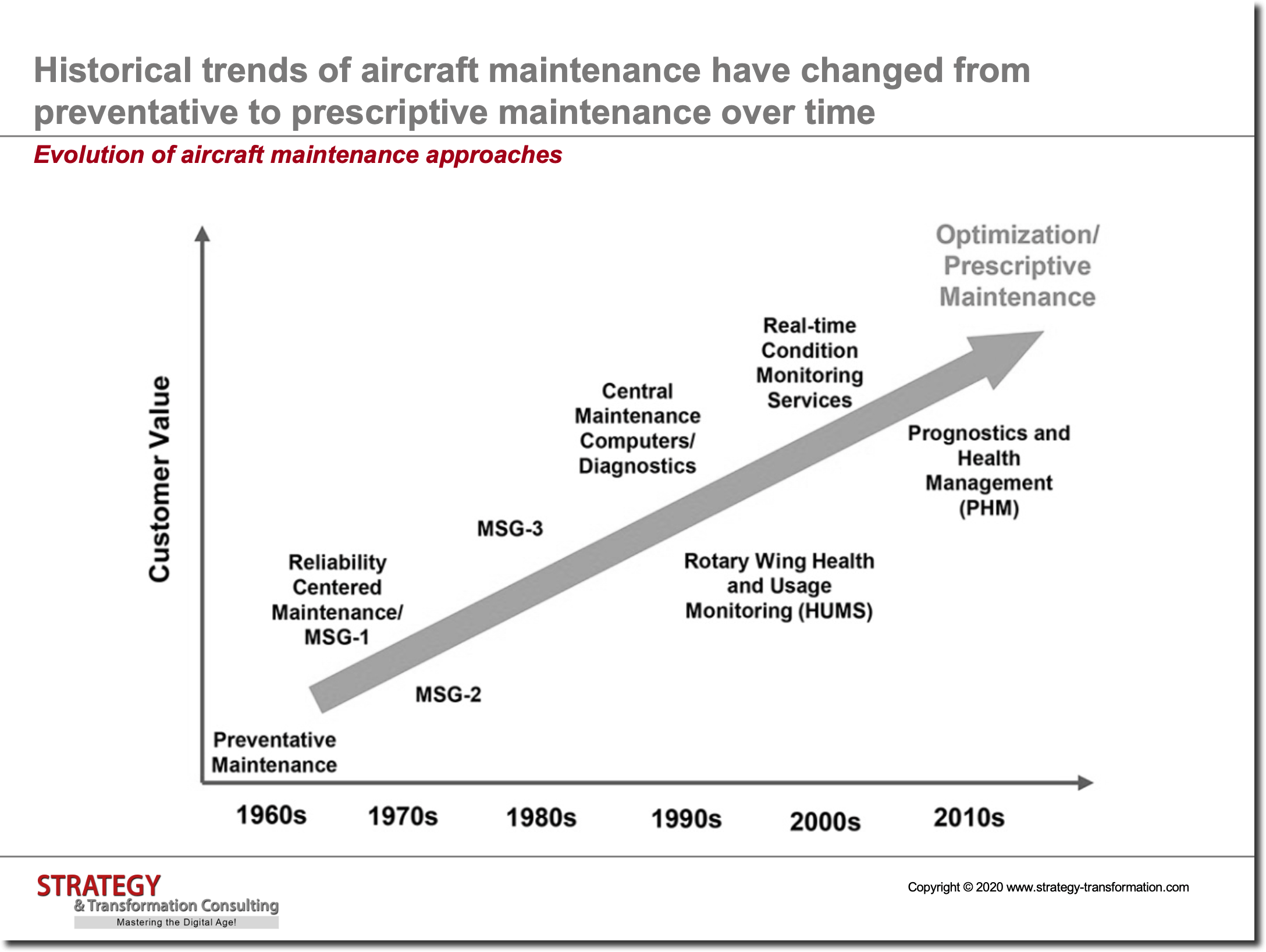
Purpose of this article
The purpose of this article is to present innovative case studies on predictive maintenance in the aeronautics industry. In the past and currently we work with airlines and Original Equipment Manufacturers (OEMs) to provide efficient frameworks for intelligent data management that will set the stage to increase aircraft availability, reduce operating costs, and improve passenger experience. Please note, that all information presented in the case studies is purely fictitious and has been significantly changed for demonstration purposes only, so that no conclusions can be drawn about our client and no confidential content is conveyed!
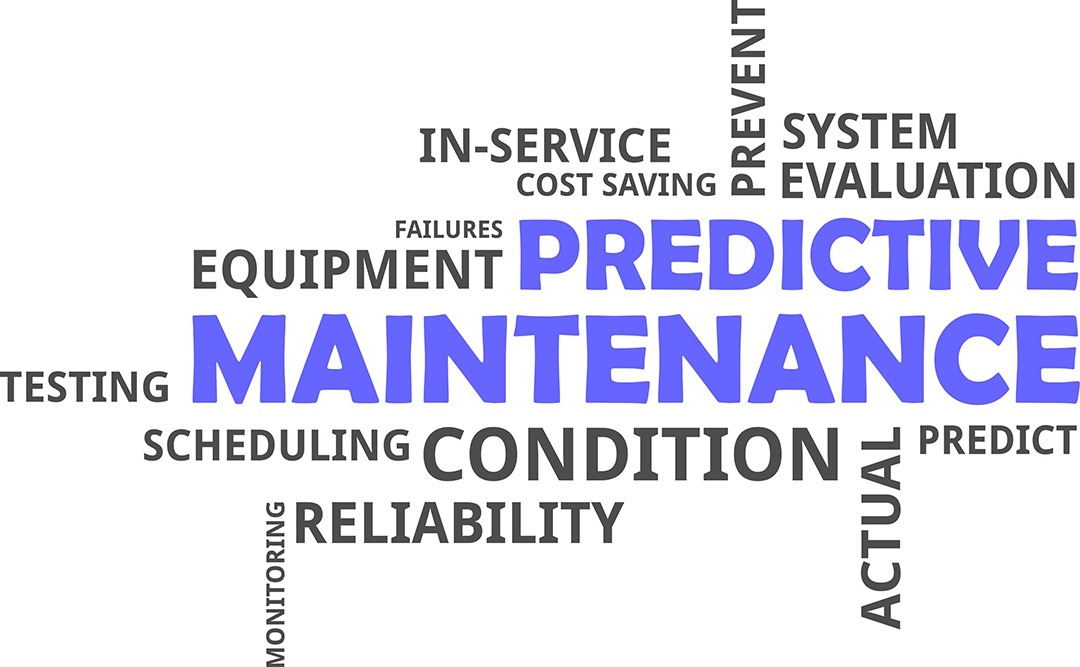
Use case #1: “Real-time” diagnostics
America Airlines (AA) flight#1522 on its route from San Francisco (SFO) to Chicago (ORD) aboard Boeing737, tail # 3203. The airplane is equipped with two Pratt & Whitney Canada (PWC) engines 306C model. While on air, half hour before arrival, the Engine Indication and Crew-Alerting System (EICAS) displayed the am-ber “ENGINE CONTROL FAULT L” message signaling that left engine Full Authority Digital Engine Control (FADEC) had detected an internal fault. The correct maintenance action is to diagnose the issue as soon as the airplane lands, replace the defected part, clear the EICAS warning, document the transaction, and authorize the airplane back to fly. A close look at the PWC engine 306C maintenance manual chapter 72-00-00 for fault isolation and expanded troubleshooting later revealed that the fault message was triggered by unusual high oil temperature that in turn was caused by a fuel heater malfunction.
Now, suppose that AA is using Amazon Web Services (AWS) services for its maintenance data management. As the EICAS message is displayed on air, the air-plane will send a maintenance request to AA repair shop in its destination (Chicago, O’Hare) with the EICAS fault description via Aircraft Communications Addressing and Reporting System (ACARS) or other communication means. Relevant data points, including higher than usual oil temperature, are also sent to the shop. The AA maintenance chief engineer noticed the high oil temperature values and relied on “Lex” tool of AWS to ask the following question:
User: Alexa, what are the probable causes of high oil temperature in PWC engine 306c? [Lex converts the audible question into text and asks the user to confirm. The user confirms the question. Alexa searches PWC engine 306C maintenance manual and responds back].
Alexa: According to PWC engine 306C Maintenance Manual chapter 72-00-00, probable causes of high oil temperature are:
– Scavenge pump failure
– Fuel heater malfunction
User: Alexa look into the maintenance history of Boe-ing737, tail # 3203 and report anything related to “Scavenge pump” and “Fuel heater”.
Alexa: Scavenge pump of Boeing737, tail # 3203 was replaced 23 days ago. Fuel heater was never replaced. It is 10-year old system. Common “fuel heater” failures include in statistical order 1) temperature sensor and 2) hot air/oil valve. [The user concluded that the most probable cause of failure is the temperature sensor of the “fuel heater” since hot air/oil valve failures are relatively less common]. He then continued.
User: Alexa, check our inventory for a fuel heater temperature sensor of a PWC engine 306C model.
Alexa: No more temperature sensors available in house. However, there are two units in “Delta Airlines” nearby maintenance shop.
User: Alexa, initiate an urgent request for a “tempera-ture sensor” part from Delta local repair shop.
Alexa: Order initiated.
User: Alexa, is there a certified technician in house available to change the fuel temperature sensor in the next half hour?
Alexa: No technician is available onsite. However, a certified technician “John Smith” is available in DuPage county, about 15-minute drive from the airport.
User: Initiate a request for Mr. John Smith to join AA repair shop in O’Hare international airport for an urgent maintenance task.
Alexa: Order initiated.
User: Alexa, send audio visual maintenance instructions on how to replace fuel heater temperature sensor to John Smith hand held device.
As the airplane lands and taxies to its designated gate, Mr. John Smith is onsite to replace the temperature sensor of the fuel heater of the PWC engine 306C of the Boeing737, tail # 3203 in its AA Flight #1522 com-ing from San Francisco (SFO). In less than 15 minutes, Technician John Smith following repair in-structions on his hand held device was able to replace the temperature sensor and made sure via the aircraft Onboard Monitoring System (OMS) that the EICAS error message is cleared. Using his hand held elec-tronic device, Mr. Smith updated the “aircraft digital twin” of the B737 aircraft tail # 303 in AWS clouds with the current maintenance transaction. This AWS based approach saved the American Airlines hours if not days of “out of service” time.
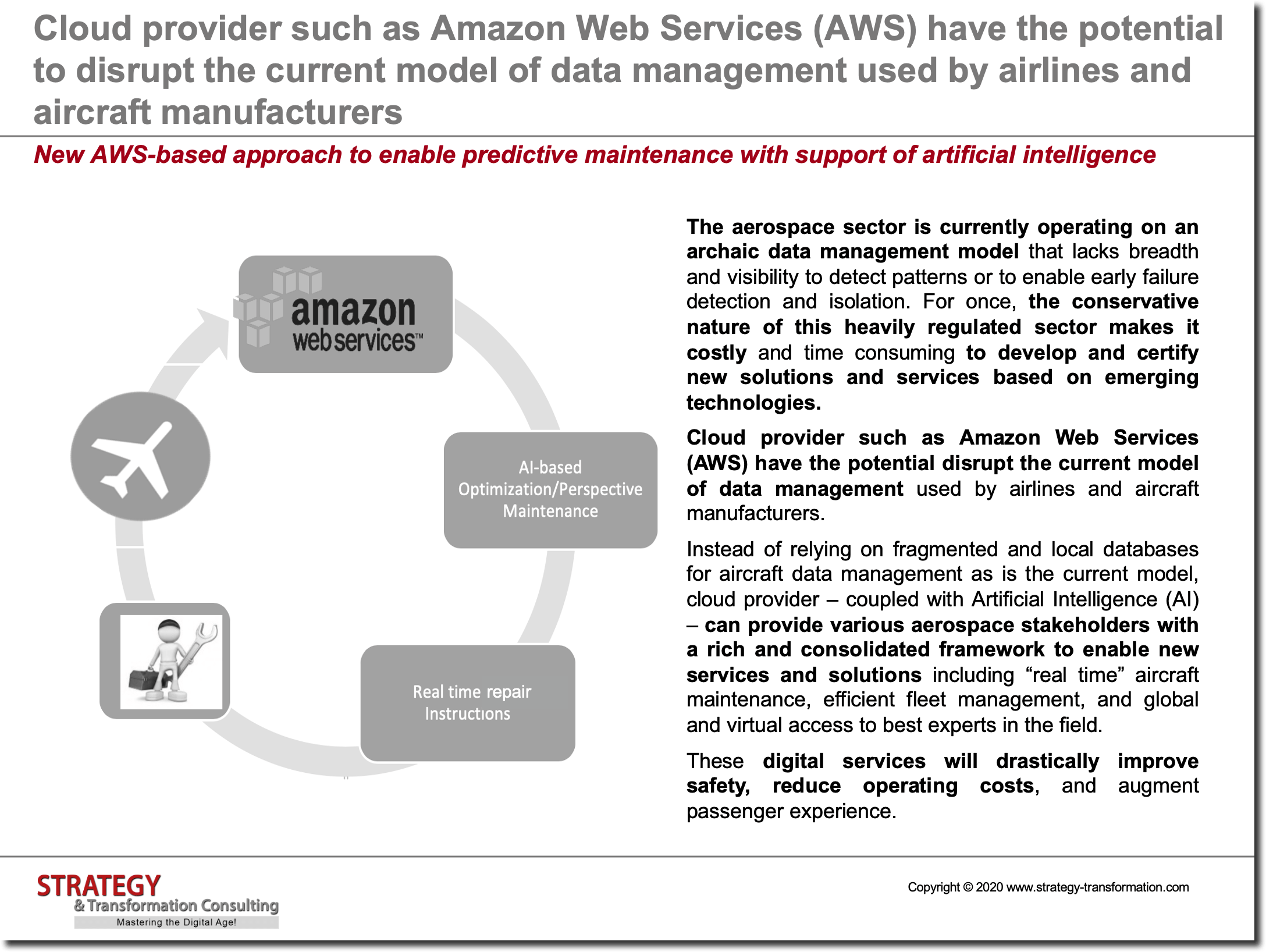
Use case #2: “Real time” flight assistance
Air France Flight 447 was scheduled to fly from Rio de Janeiro, Brazil to Paris, France on June 1st 2009 but never made it! The Airbus A330 did not recover from an aerodynamic stall and crashed into the Atlantic Ocean killing all 228 persons onboard. The investigating team concluded that the aircraft crashed after temporary inconsistencies between airspeed meas-urements that happened most likely due to speed sensors being covered by ice crystals. Those incon-sistent sensor readings led the autopilot to disconnect and then misled the crew to react incorrectly based on such inconsistent sensor data causing the aircraft to enter into an aerodynamic stall, from which it did not recover. The accident was the deadliest in the history of Air France.
Now let’s imagine that the aircraft was connected to the internet (via ACARS or other services) and had access to AWS services. Through real time data collection and processing powered by AWS framework, the pilot via a chat bot could have had the following dialogue:
Pilot: Alexa, why did the autopilot disconnect?
Alexa: Autopilot disconnected because airspeed data is inconsistent. Be cautious to change the aircraft speed and altitude based on current airspeed sensor readings.
Pilot: Based on other relevant data, what is the air-craft estimated speed?
Alexa: Based on current fuel burning rate, aircraft mass, drag, local weather conditions, flight trajectory, and recent consistent airspeed measurements the aircraft speed is approximately 450 knots.
The pilot would have taken the correct actions based on estimated speed values and avoided stalling the aircraft until consistent airspeed sensor readings were recovered.

Use case #3: Prognostics
Consider this news snippet from CNN (published on 12/4/2015):
The U.S. Army on Thursday grounded aircraft for ac-tive duty aviators at 11 posts across the country fol-lowing a series of deadly crashes in recent weeks.
According to a release from the U.S. Army Forces Command, the order „will permit Army aviation leaders specific time to review Army aviation-training proce-dures and helicopter-safety precautions to manage risk, and to avoid accidental loss of aviation personnel and equipment.“
Gen. Robert B. Abrams said in the release that the „decision to ground our aircraft today is taken with the utmost seriousness and my responsibility as the Commander of U.S. Army Forces Command.“
„I have a duty to ensure that we are doing all that we can to prevent loss of life and aviation accidents,“ Gen. Abrams said, „and that is why we’re standing down to review our procedures and reaffirm our commitment to operating our aircraft safely and effectively. Our thoughts and prayers are with the families of the sol-diers who died recently in these accidents.“
There has been a string of fatal helicopter crashes during training missions over the last few weeks.
Four crew members on an Army helicopter died when it crashed at Fort Hood during a routine training mis-sion on November 23, and two other pilots were killed the same day also in a helicopter crash during a train-ing exercise in South Korea, according to Reuters. Two more aviators flying out of Fort Campbell were killed in another training exercise when their helicopter went down in Kentucky on Tuesday, as reported by the Courier-Journal.
In fact, rotor aircraft catastrophic failures still continue to be a major problem negatively affecting the Department of Defence (DOD) in multiple fronts including training and combat readiness, troop morale, and DOD bottom line. In early 2000s, the Army and Navy in-vested hundreds of millions of dollars to equip thou-sands of their helicopter fleet with HUMS systems mainly provided by Goodrich (now part of UTC). HUMS systems collect huge amounts of vibration data and other sensor measurements in a bid to enable a Condition Based Maintenance (CBM) approach rather than relying on the traditional schedule-based mainte-nance scheme that has become cost prohibitive. Collected HUMS data are stored in fragmented databases across multiple ground stations.
Now, suppose that data are uploaded to AWS infrastructure with enabling AI tools to allow DOD experts to train Machine Learning (ML) models with huge sets of data for various purposes to:
- Determine causes of accidents
- Diagnose root causes of failures
- Track the health and usage of each helicopter (i.e. digital twin model)
- Estimate remaining life spans of critical components and systems of the rotorcraft
- Schedule maintenance time slots based on air-craft condition and other available resources
With these game changing capabilities the Department of Defence (DOD) will be able to deliver on all critical fronts.
Suggested approach: Structure follows strategy!
In general, asset performance (“uptime”) conflicts with maintenance cost and asset risk. Maintenance strategies must be defined per plant/line depending on engineering and business needs. Strategy decisions should be evaluated based on facts & figures and external benchmarks.
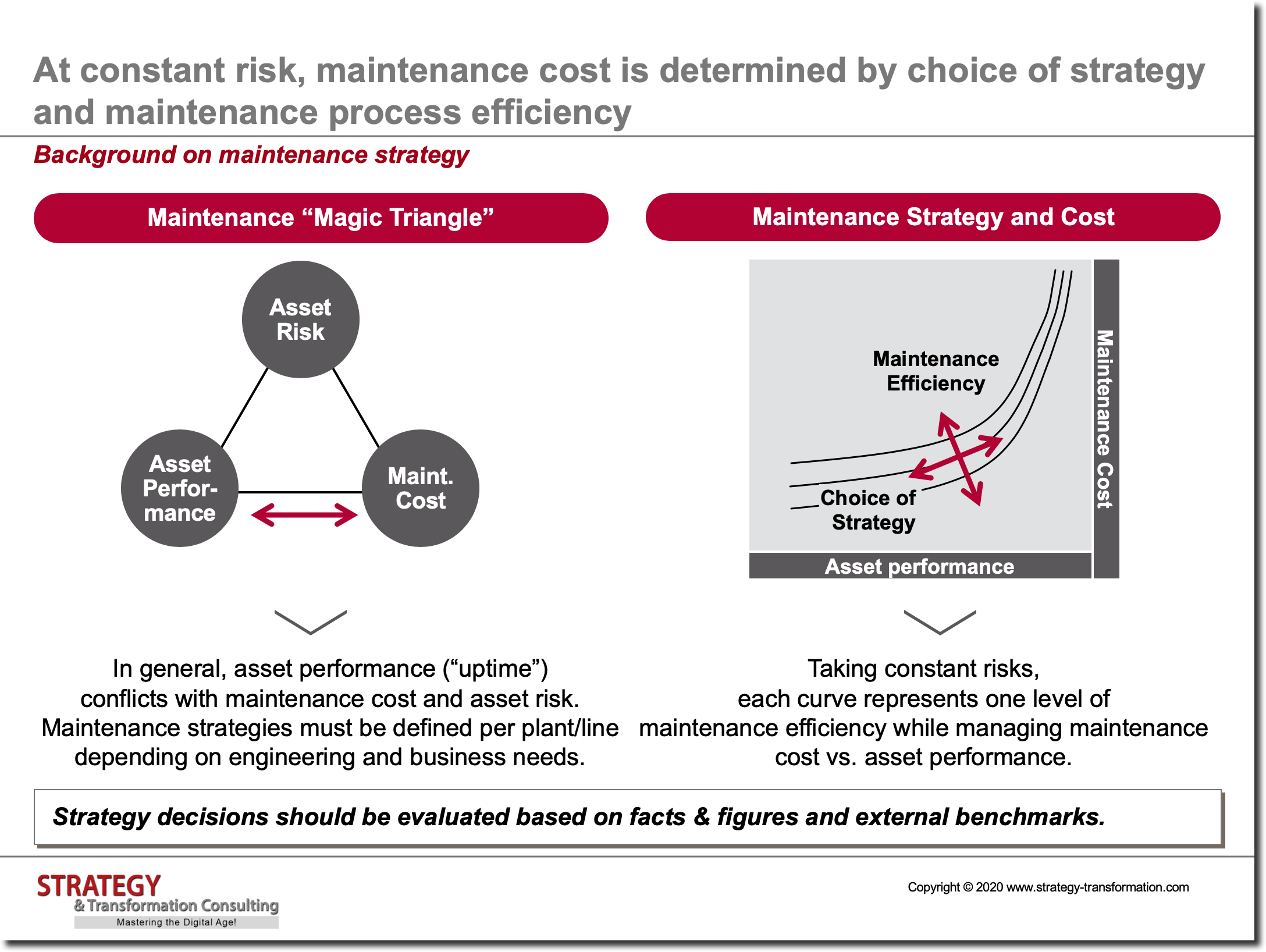
„If a man does not know to which port he sails, no wind is favorable – Seneca“. We as strategists fully agree with Seneca’s quote from 65 A.D. We recommend that corporations always start with the strategy definition first and only then work out the associated company structures and suitable technologies. In our view, this also applies to the topic digitization of maintenance. For this reason, we have developed our own maintenance framework, which should help as a guide in the development of a holistic maintenance strategy. Our framework consists of 7 levels. Details can be found in the graphic below.
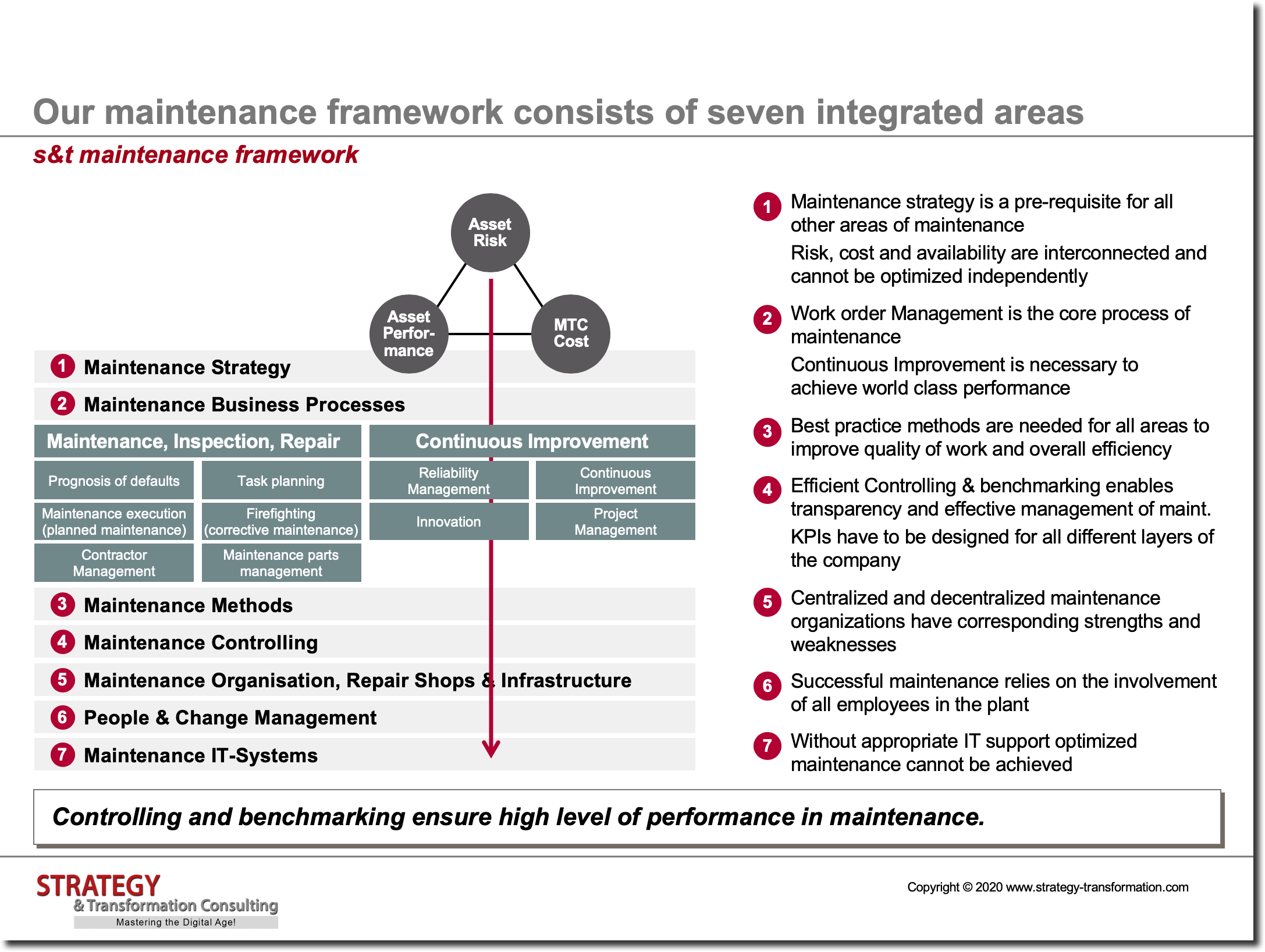
Conclusion
The aerospace sector is currently operating on an archaic data management model that lacks breadth and visibility to detect patterns or to enable early failure detection and isolation. For once, the conservative nature of this heavily regulated sector makes it costly and time consuming to develop and certify new solutions and services based on emerging technologies. Cloud provider such as Amazon Web Services (AWS) have the potential disrupt the current model of data management used by airlines and aircraft manufacturers. Instead of relying on fragmented and local databases for aircraft data management as is the current model, cloud provider – coupled with Artificial Intelligence (AI) – can provide various aerospace stakeholders with a rich and consolidated framework to enable new services and solutions including “real time” aircraft maintenance, efficient fleet management, and global and virtual access to best experts in the field. A rich cloud computing framework for early and accurate diagnosis and prediction of complex failures will definitely change the current way of managing aircraft data and will soon be a reality that will enhance further aerospace safety and drastically reduce operating costs, and augment passenger experience. Cloud provider such as AWS should be the driving force behind such a change and actively approach aerospace OEMs, airlines, air forces an other stakeholders in the market with relevant predictive maintenance service offerings and value propositions.
Related links
Artificial Intelligence and Machine Learning in the Insurance Sector
Trends in Data-Driven Internet of Things (IoT)
Das Potenzial von Daten durch Business Analytics voll ausschöpfen!
How to approach Business Analytics? A guide for better insights out of big data
The ROI of a Modern Data Strategy
Fachkompetenz Business Analytics
Fachkompetenz strukturelle Ausrichtung
Branchenkompetenz produzierende Industrie
About us
Our positioning and mission statement: “Mastering the Digital Age!” We are an integrated management and technology consulting group and offer the conception and implementation of holistic digitization solutions in an integrated manner. In combination, you will receive strategic advice from us on the digitization of your company from real thought leaders with profound methodological knowledge, extensive transformation experience from successful IT system integrators with many years of industry experience and a high level of technological understanding, as well as deep expertise in generating value from data – the new gold of the 21st century – with the help of the latest artificial intelligence (AI) and cloud computing technologies. All this End2End from a single source for the entire transformation process! Find out more about us here.
Did we spark your interest?
Are you facing similar challenges in your company? Do you have any questions about the case study described? If you are interested in an in-depth discussion, then write us an email or give us a call. We would be happy to present our consulting products and digital solutions to you in a personal discussion. We are looking forward to meet you!

Dr. Mokhtar Sadok
Partner, Business Analytics / Artificial Intelligence / Big Data Practice
Strategy & Transformation Consulting
Email senden

Kommentare geschlossen